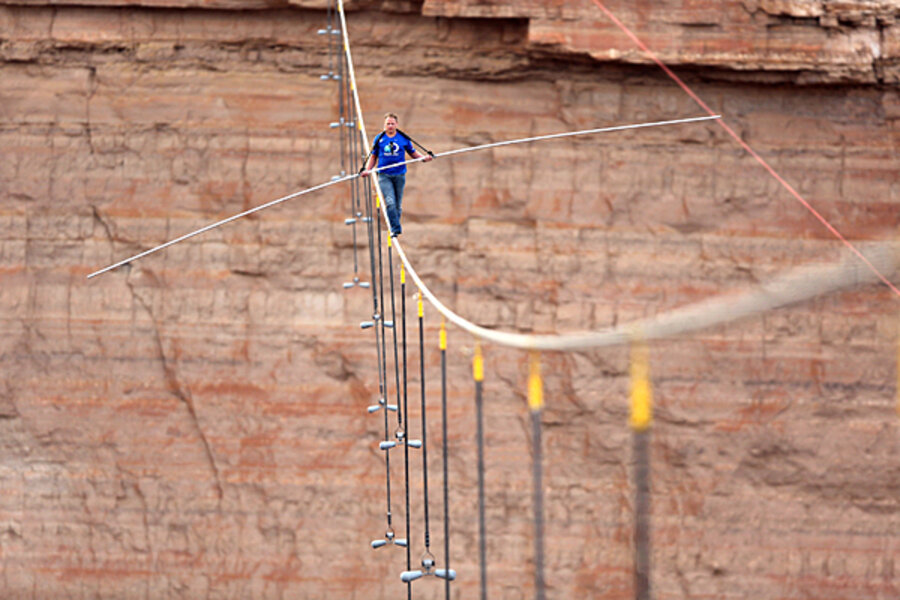Grand Canyon tightrope walk: What was that huge pole for?
Loading...
To help him complete his journey along a 1,400-foot-long, 2-inch-thick steel cable that had been stretched across the Little Colorado Gorge, Nik Wallenda, a seventh-generation member of the legendary Flying Wallendas family of acrobats, brought with him a cross necklace, a pair of thin-soled shoes, and a flexible, 30-foot-long, 43-pound pole.
The reasons for the devotional object and the footwear are obvious to most of us who watched Mr. Wallenda teeter over the river some 1,500 feet below, but what was that huge drooping pole for? And why did it have to be so heavy?
To help him keep his balance. To prevent their death-defying acts from becoming life-defying ones, high-wire artists seek to increase their rotational inertia and lower their center of gravity.
First, rotational inertia: If you're walking on a tightrope hundreds of feet above the ground, the very last thing you want to do is start rotating around it. The way to prevent that is to increase your rotational inertia.
Just as more force is needed to accelerate a more massive object from rest, more rotational force – or torque, as physicists like to say – is needed to spin an object with more rotational inertia. You can increase this by carrying more mass, and by keeping as much of that mass as far away as possible from your tightrope. Your tightrope is the one thing that you definitely don't want to become an axis of rotation.
Physics teachers like to bring up the example of figure skaters' arms. As a twirling skater draws her arms in, she begins twirling faster. That's because, by bringing her arms closer to the center of her axis, she decreases her rotational inertia. Her angular momentum is the product of her angular velocity and rotational inertia, so because momentum must be conserved, her speed changes as she decreases her rotational inertia. Rotational inertia increases as the square of the distance from the axis, which is why such an apparently small change in position can have a huge effect on her velocity.
And the same thing works in reverse. By increasing his rotational inertia, Nik Wallenda's pole helps to slow his rotation around the tightrope, giving him more time to react as he starts to tip in one direction or another.
The other advantage to Wallenda's heavy, flexible pole is that it lowers his center of gravity. If you're standing on the ground, the easiest way to make yourself harder to knock over would be to spread your feet apart and bend your knees. But that wasn't really an option for Wallenda as he walked across the gorge.
This is why the poles he carried was flexible instead of rigid. The weight causes the pole to droop, bringing the center of gravity of the Wallenda plus pole system closer to the steel cable.
For all its advantages, however, Wallenda seemed to be happy to be rid of the pole as soon as it was safe.
"My arms are aching like you wouldn't believe," he told Reuters, after he finished his 22-minute journey.








